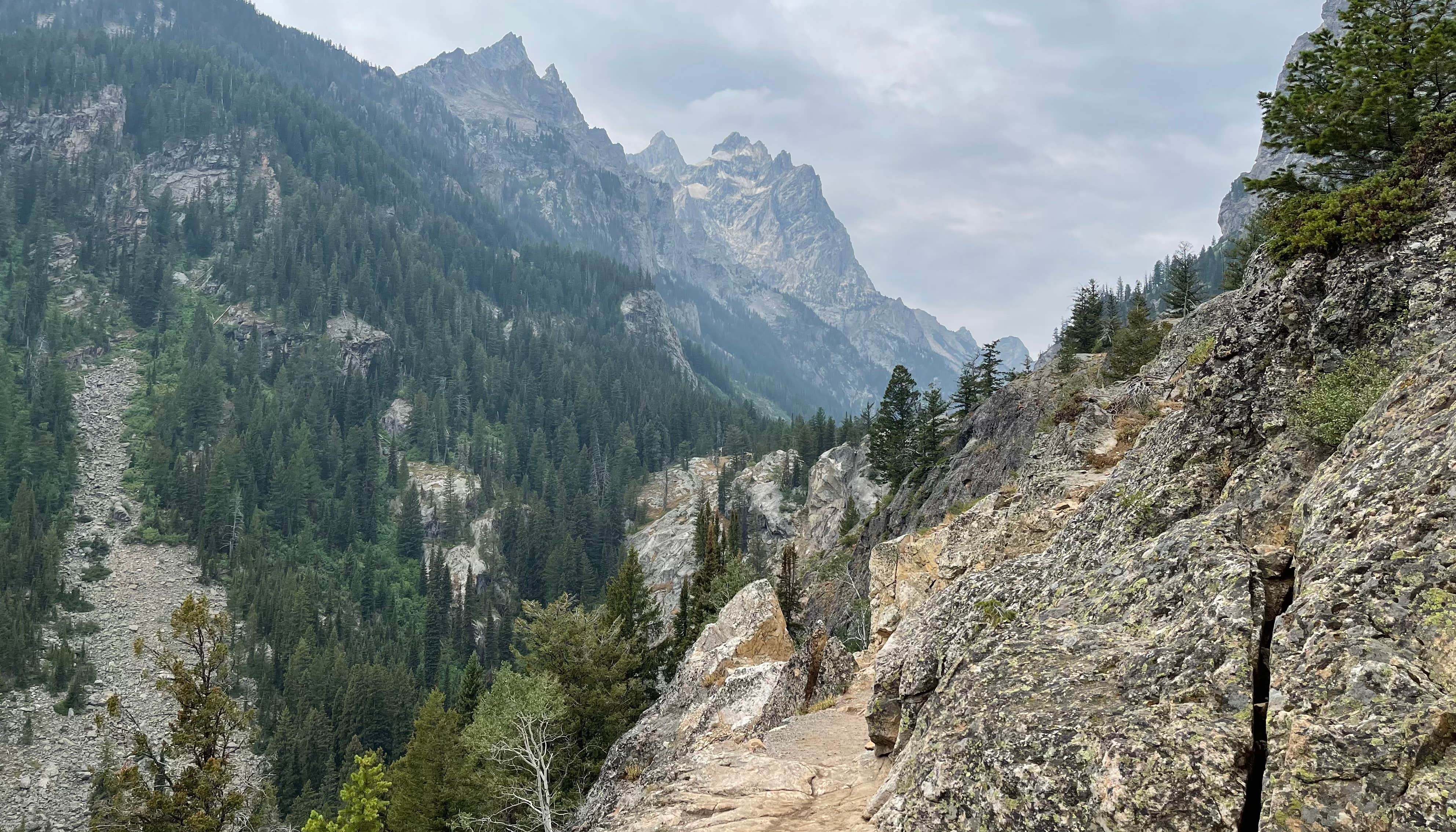Complete Guide to Camping in Grand Teton National Park
Grand Teton National Park offers camping beneath the iconic spires of the Teton Range and along pristine alpine lakes. The park's seven campgrounds span the Jackson Hole valley, from the southern sagebrush flats near Jackson to the pine forests along Jackson Lake in the north. Each location provides a unique setting with panoramic mountain views, wildlife viewing opportunities, or convenient amenities to suit different camping preferences. Planning ahead is essential, as campsites are in high demand throughout summer and must be reserved months in advance.
Camping in Grand Teton ranges from full-service RV sites with hookups to rustic tent-only enclaves and free dispersed camping just outside park boundaries. Nights get cold at 6,000+ feet elevation even in peak season, often dropping into the 30s°F, so warm gear is necessary. With both black and grizzly bears roaming the park, proper food storage is mandatory at all sites - every campground provides bear-proof lockers to keep campers and wildlife safe. Whether you want to sleep near Jackson Lake's shore under star-filled skies with Tetons reflected in the water or beneath evergreens with elk bugling in the distance, this guide will help you plan the perfect Grand Teton camping adventure.
Grand Teton National Park Camping at a Glance
All Grand Teton campgrounds transitioned to a 100% advance reservation system as of 2021, with no first-come, first-served sites remaining within the park. Reservations must be made through Recreation.gov on a rolling 6-month basis, with sites becoming available at 8:00 AM Mountain Time exactly six months before arrival. Competition is fierce, with popular campgrounds like Jenny Lake booking within minutes when reservations open.
Sites range from $36 to $85 per night depending on campground and amenities. Most campgrounds operate from late April through early October, with Jenny Lake having the shortest season due to elevation and recent renovations. Summer nights regularly drop into the 30s°F even in July, requiring warm sleeping gear year-round. The park's 2024 visitation of 3.63 million makes advance planning essential for any camping experience.
Grand Teton National Park Campground Quick Facts
| Quick Facts | Details |
|---|---|
| Number of Campgrounds | 7 campgrounds inside Grand Teton National Park (with ~1,000 sites total) ranging from large campgrounds near Jackson Hole to small tent-only loops by Jenny Lake. All campgrounds are reservation-only (no first-come sites), and there are an additional ~14 free primitive campsites along the John D. Rockefeller Parkway north of the park. |
| Campsite Costs | Approximately $40-$80 per night for most standard campsites (tent or RV) in peak season. Tent-only sites on the lower end ($40) and RV sites or sites with hookups on the higher end ($70-$80). Group campsites (at Gros Ventre and Colter Bay) cost more, and hiker/biker sites (at Jenny Lake, Colter Bay) offer lower per-person rates. Senior or Access Pass holders receive 50% off standard site fees in many campgrounds. |
| Reservation Platform | Recreation.gov – all park campgrounds must be booked online up to 6 months in advance. New sites become available on a rolling 6-month basis (at 8:00 AM MST each day for dates six months out). No drive-up first-come camping is available in-park, so reserve early (campgrounds can fill months in advance during summer). |
| Camping Season | Short summer-focused season. No Grand Teton front-country campgrounds are open year-round. The longest seasons run from late April to early/mid-October (e.g., Gros Ventre Apr 26-Oct 10, Colter Bay RV Park May 3-Oct 10). High-elevation and tent-only sites open later or close earlier (e.g., Jenny Lake Campground in 2025 is open July 1-Sept 28 due to renovations). All campgrounds close by mid-October for winter, though winter backcountry camping is possible by permit. |
| Temperature Ranges | Summer: Warm days (highs ~75-85°F) and cold nights (lows in the 30s-40s°F). Frequent afternoon thunderstorms in July-August. Fall: Sunny, crisp days (50-60°F) and freezing nights; gorgeous foliage in late September, but some snow possible by Oct. Spring: Unsettled weather (cold rain or snow common through May, highs 40-60°F). Valley snowpack persists into May, limiting early-season camping. Winter: Very cold (highs 20s°F, lows 0-10°F) with deep snowpack (~14 feet annually in valley). All roads and facilities are snow-covered except main highways; winter camping is limited to designated backcountry areas with a permit. |
| 2025 Updates | Jenny Lake Campground Delays: Renovation work and heavy snowpack pushed opening to July 1, 2025 (later than usual). The campground now features hot showers for the first time, thanks to recent upgrades. 100% Reservation System: As of 2021-2022, all park campgrounds moved to reservation-only — no first-come camping — which continues in 2025. Backcountry Permit Fees: Starting in 2024, backcountry camping permits cost $20 + $7 per person/night (70% of permits are held for day-before walk-ins). Record Visitation: 2024 was the park's second-busiest year ever with 3.63 million visits, so expect competition for campsites; park campgrounds are essentially full every night from June through September. |
Grand Teton Campgrounds: Complete Guide
In-Park Campgrounds
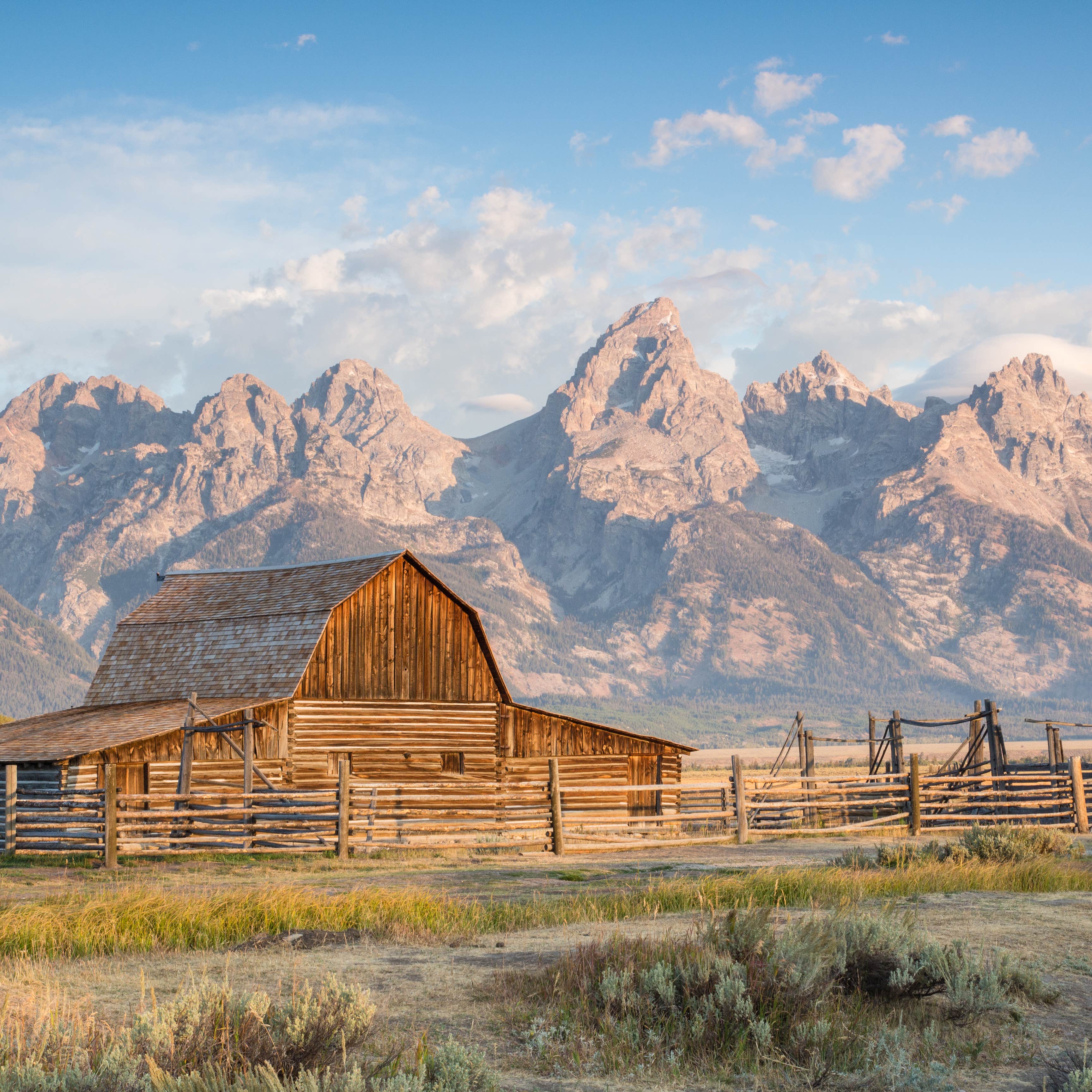
Gros Ventre Campground — Grand Teton National Park
Gros Ventre Campground sits in the southern end of the park, 11 miles from the Moose entrance. This largest campground in Grand Teton offers 300 sites spread over several loops in a cottonwood and sagebrush setting along the Gros Ventre River. The campground provides flush toilets, dump station, and potable water. Sites include picnic tables, fire rings, and food storage lockers. Gros Ventre accommodates tents and RVs up to 45 feet, though no hookups are available. The campground's location provides good access to the town of Jackson (12 miles south) while keeping you within park boundaries.
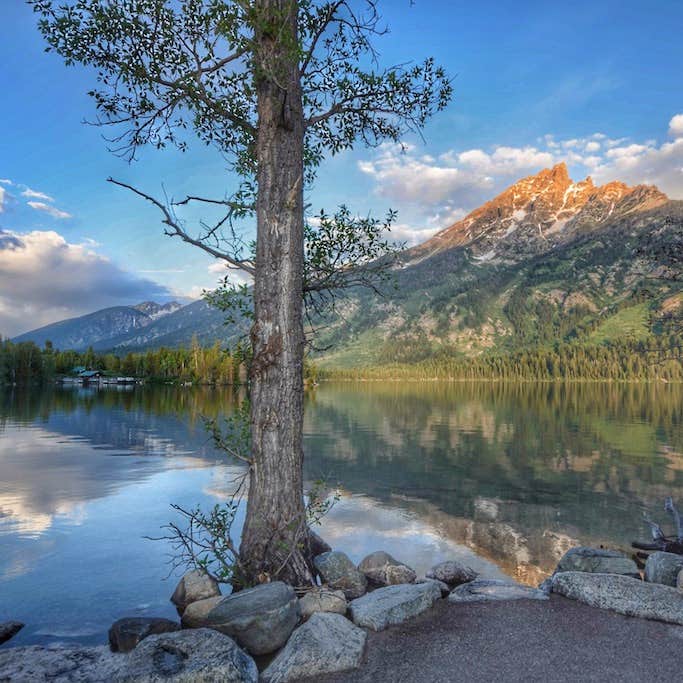
Jenny Lake Campground — Grand Teton National Park
Jenny Lake Campground contains 61 tent-only sites at the base of the Teton Range. Recently renovated, this small campground offers a rustic mountain experience with the newly-added bonus of hot showers. Sites sit beneath lodgepole pines within walking distance of Jenny Lake's shoreline. Each site includes a picnic table, fire ring, and food storage locker. The campground provides flush toilets and drinking water. Site size is limited, with no space for RVs or trailers (strictly tent camping). Jenny Lake's location puts campers minutes from popular trailheads to Hidden Falls, Inspiration Point, and Cascade Canyon.
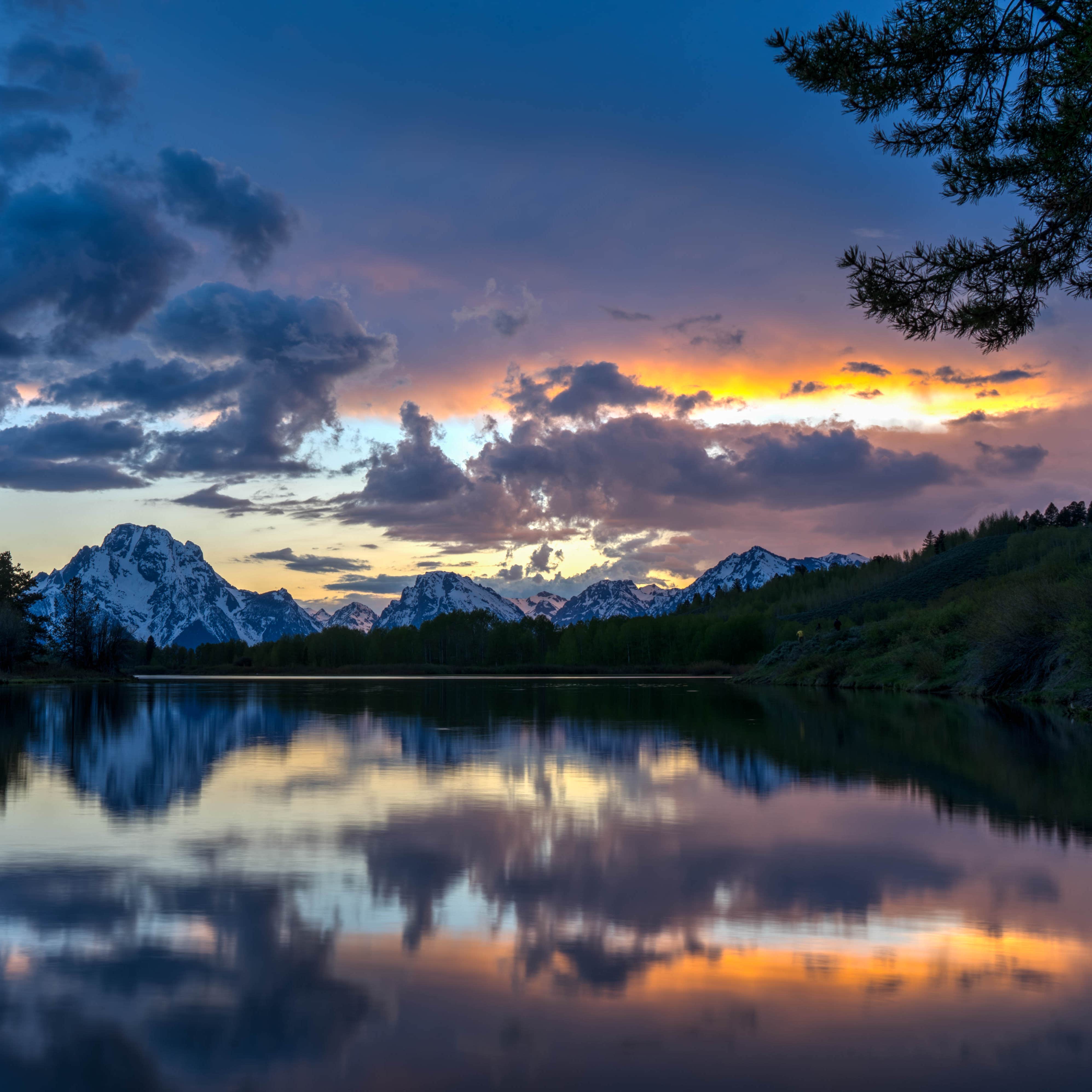
Signal Mountain Campground — Grand Teton National Park
Signal Mountain Campground features 56 sites on a forested hill above Jackson Lake. Located 11 miles north of Jenny Lake, this mid-sized campground offers a mix of sunny and shaded spots. The campground provides flush toilets, drinking water, and a dump station. Each site includes a picnic table, fire ring, and food storage locker. Sites accommodate tents and RVs up to 30 feet, though no hookups are available. Signal Mountain's elevation provides excellent views of Jackson Lake and the Teton Range from certain spots.
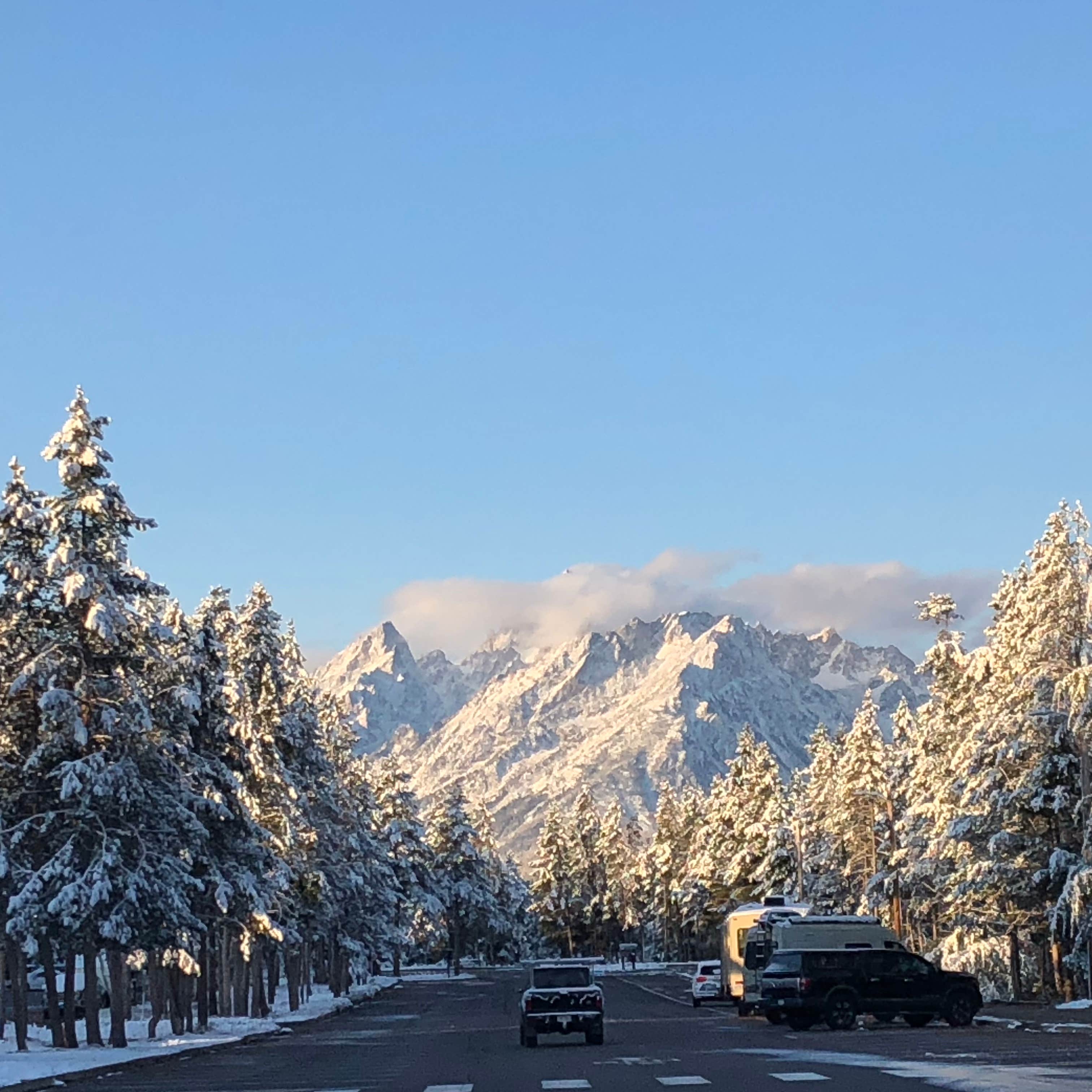
Colter Bay Campground — Glendo State Park
Colter Bay Campground contains 324 sites in a lodgepole pine forest near Jackson Lake, approximately 25 miles north of Jenny Lake. This large campground provides flush toilets, potable water, and proximity to the full-service Colter Bay Village area. Sites include picnic tables, fire rings, and food storage lockers. The campground accommodates tents and RVs up to 30 feet in length (no hookups available). The adjacent Colter Bay Village offers extensive amenities: visitor center, restaurants, general store, laundry, showers, gas station, marina, and horseback riding concession.
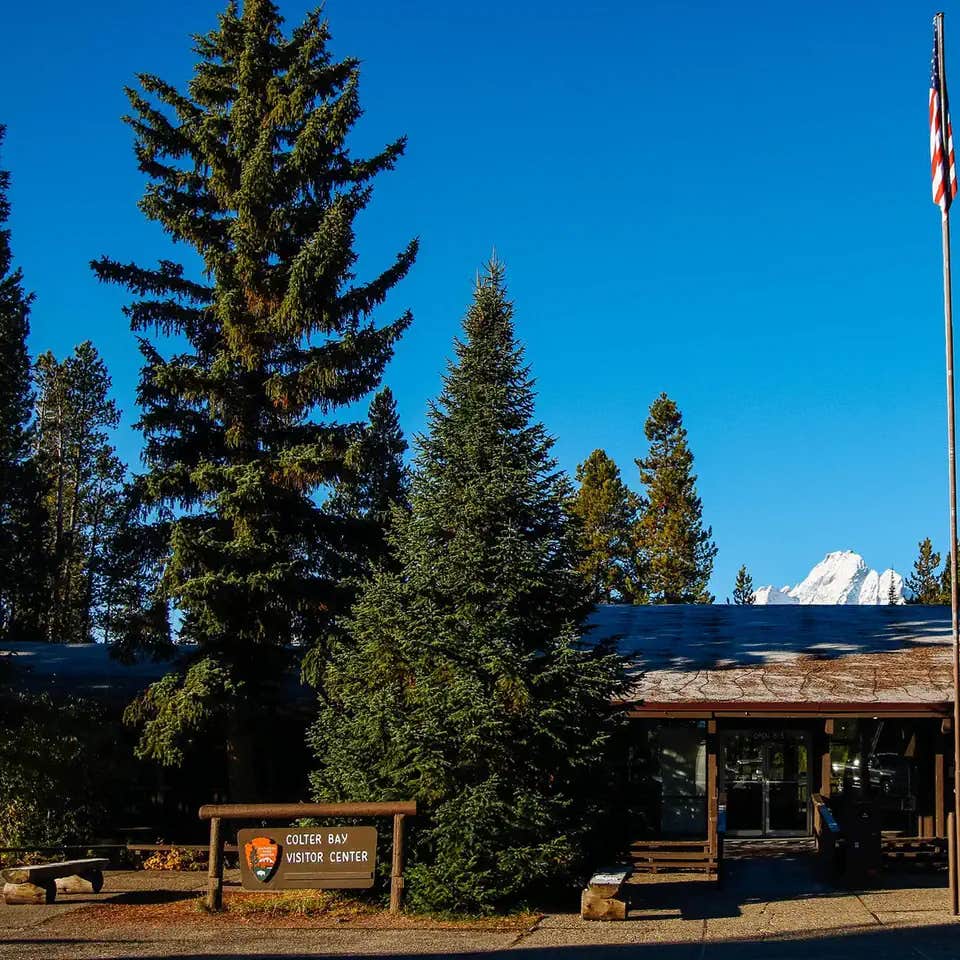
Colter Bay RV Park at Colter Bay Village — Grand Teton National Park
Colter Bay RV Park provides 112 sites with full hookups (water, electric, sewer) specifically for RVs, located adjacent to Colter Bay Village. This RV-focused facility is the only in-park option with full utility connections. Sites include picnic tables, fire rings, and food storage lockers. The RV park accommodates vehicles up to 45 feet in length and provides easy access to all Colter Bay Village amenities: showers, laundry, restaurants, general store, and marina. Sites are arranged in a more parking-lot style layout with less privacy than other campgrounds but maximum convenience for RV users.
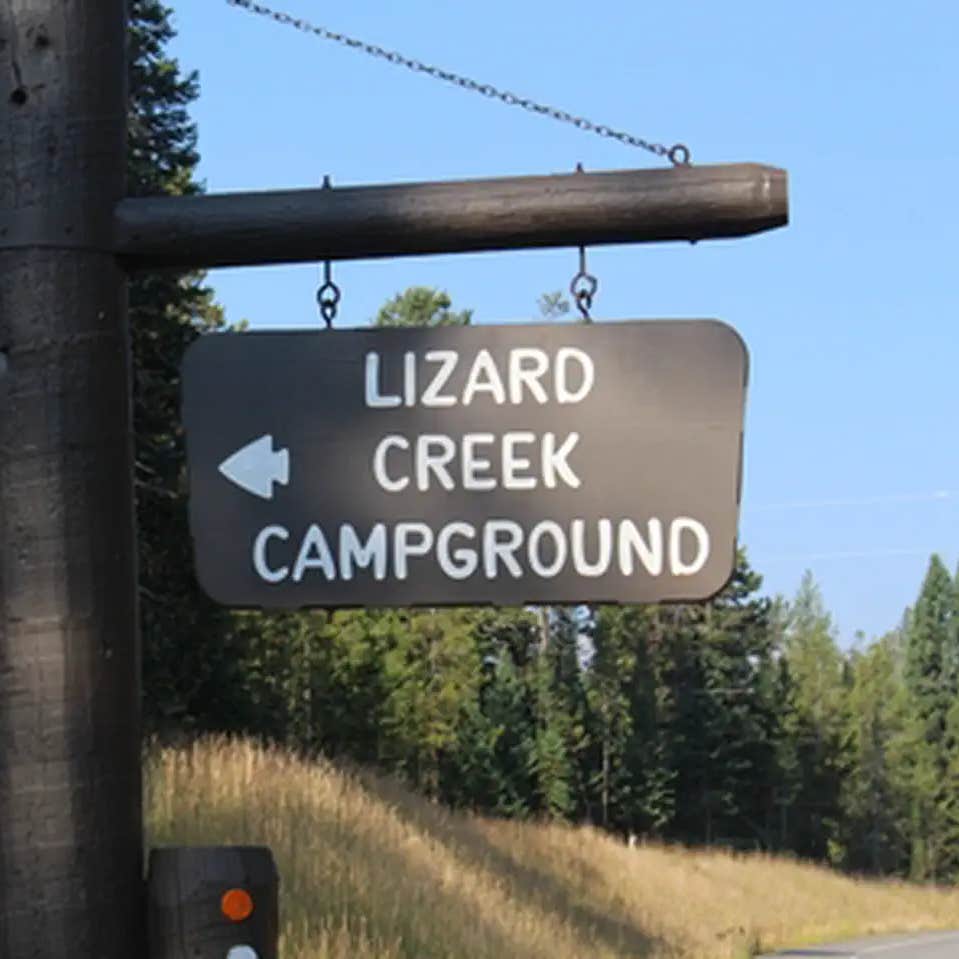
Lizard Creek Campground — Grand Teton National Park
Lizard Creek Campground offers 60 sites in a spruce-fir forest along the northern shore of Jackson Lake, about 32 miles north of Jenny Lake. This small, relatively remote campground provides a more primitive experience with vault toilets and potable water. Sites include picnic tables, fire rings, and food storage lockers. The campground accommodates tents and RVs up to 30 feet, though its roads are narrow and winding. No hookups or dump station are available. Lizard Creek sits at a higher elevation than other park campgrounds, creating cooler temperatures even in summer.
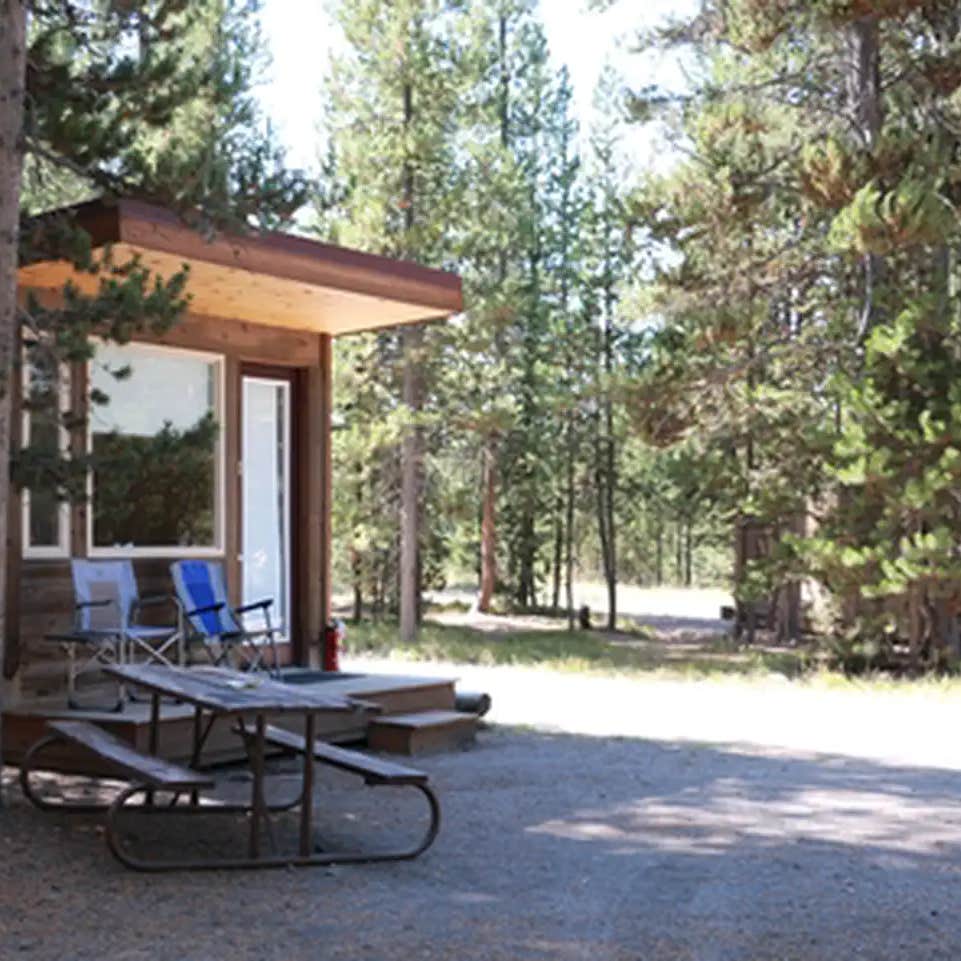
Headwaters Campground at Flagg Ranch — John D. Rockefeller, Jr., Memorial Parkway
Headwaters Campground at Flagg Ranch contains 97 sites located in the John D. Rockefeller Jr. Memorial Parkway between Grand Teton and Yellowstone National Parks, about 55 miles north of Jenny Lake. This campground offers flush toilets, showers, and a full-service RV park with hookups. Sites include picnic tables, fire rings, and food storage lockers. The campground accommodates tents and RVs up to 45 feet in length. The adjacent Flagg Ranch complex provides a restaurant, gas station, and small general store.
Outside the Park Options
Shadow Mountain Dispersed Camping provides free camping on Bridger-Teton National Forest land just east of Grand Teton National Park, approximately 15-20 minutes from the Moose entrance. This popular dispersed camping area offers numbered spots with no amenities except seasonal portable toilets at some locations. Camping is allowed only in designated areas along the rough dirt road that climbs Shadow Mountain. Sites offer no facilities - no water, no toilets, no picnic tables, and no fire rings (though fire rings have been built at many established sites). The main draw is the spectacular panoramic Teton views across the valley.
Curtis Canyon Campground features 12 sites on national forest land east of Jackson, perched on a hillside overlooking the National Elk Refuge and Jackson Hole valley. This small Forest Service campground provides vault toilets and potable water. Sites include picnic tables and fire rings. The campground accommodates tents and small RVs or trailers (challenging access road). Sites sit in a mixed conifer/aspen forest with excellent views from many spots.
Virginian RV Park contains 103 full-hookup sites located in the town of Jackson, about 20 minutes south of Grand Teton's Moose entrance. This private RV park offers full amenities: water, electric, sewer hookups, Wi-Fi, cable TV, laundry facilities, and hot showers. Sites include picnic tables with paved pads. The RV park accommodates vehicles of all sizes with pull-through and back-in options.
Fireside Resort offers 25 luxury tiny home cabins and glamping tents near Wilson, Wyoming, approximately 15-20 minutes south of Grand Teton's Moose entrance. This upscale property provides fully-furnished tiny homes with kitchens, bathrooms, heating/AC, Wi-Fi, and private decks with fire pits. The resort accommodates those seeking a camping atmosphere with hotel-like amenities.
Campground Comparison Table
| Campground | Location & Sites | Cost & Amenities |
|---|---|---|
| Gros Ventre | Southern GTNP, 11 mi from Moose 300 sites at 6,500 ft | $40/night Flush toilets, water, dump station |
| Jenny Lake | Central GTNP, base of Tetons 61 sites (tents only) at 6,800 ft | $42/night Flush toilets, water, new showers |
| Signal Mountain | Central GTNP, above Jackson Lake 56 sites at 6,900 ft | $42/night Flush toilets, water, dump station |
| Colter Bay | Northern GTNP, near Jackson Lake 324 sites at 6,800 ft | $42/night Flush toilets, water, village amenities |
| Colter Bay RV Park | Northern GTNP, near Jackson Lake 112 sites at 6,800 ft | $80/night Full hookups, village amenities |
| Lizard Creek | Northern GTNP, on Jackson Lake 60 sites at 7,000 ft | $36/night Vault toilets, water |
| Headwaters (Flagg Ranch) | Between GTNP & Yellowstone 97 sites at 6,900 ft | $55-85/night Flush toilets, showers, hookups available |
| Shadow Mountain | BTNF, east of GTNP ~30 dispersed sites at 7,000-8,000 ft | Free None (seasonal porta-potties only) |
| Curtis Canyon | BTNF, east of Jackson 12 sites at 7,500 ft | ~$20/night Vault toilets, water |
| Virginian RV Park | Town of Jackson 103 sites at 6,200 ft | $75-95/night Full hookups, Wi-Fi, showers, laundry |
| Fireside Resort | Wilson, WY (south of park) 25 cabins/tents at 6,300 ft | $225-450/night Luxury tiny homes, full utilities, Wi-Fi |
Campground Amenities and Best Uses
Park Campgrounds: In-park options range from the intimate Jenny Lake (tent-only with mountain views) to the large Colter Bay (full village amenities). Gros Ventre offers the best wildlife viewing and proximity to Jackson, while Signal Mountain provides lake views and moderate amenities. Lizard Creek delivers solitude and cooler temperatures in a remote northern location.
Grand Teton RV-Specific Options: Colter Bay RV Park is the only in-park option with full hookups, while Headwaters at Flagg Ranch offers convenience for those visiting both Grand Teton and Yellowstone. Virginian RV Park provides maximum amenities and town access.
Budget and Free Options: Shadow Mountain dispersed camping offers spectacular Teton views at no cost but requires self-sufficiency. Curtis Canyon provides a middle ground with basic amenities and valley views.
Luxury Options like Glamping: Fireside Resort caters to glampers seeking outdoor atmosphere with hotel-level comfort and amenities. Other campgrounds like Fireside Resort at Jackson Hole offer tiny homes for camping options.
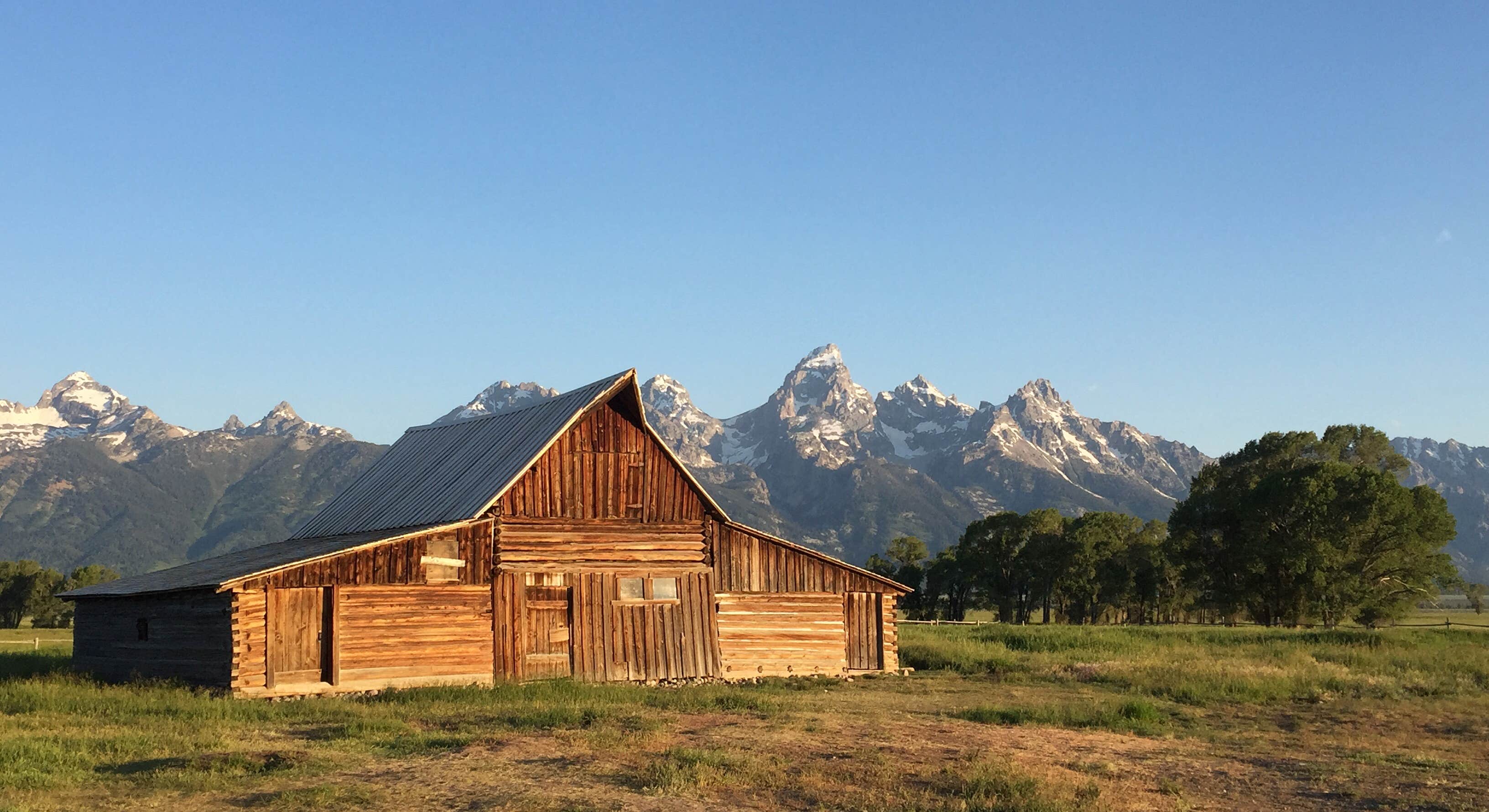 Photo by Stephanie Z
Photo by Stephanie Z
Planning Your Grand Teton Camping Trip 
When to Visit
| Season | Temperatures | Advantages & Challenges |
|---|---|---|
| Summer (Jun-Aug) | 77-85°F / 35-45°F (warm days, cool nights) | All campgrounds open; best weather for hiking, backpacking, boating. Long daylight hours. Wildflowers peak in late June/July. Park activities, ranger programs in full swing. Crowds & competition — peak tourist season (reservations essential). Frequent afternoon thunderstorms (especially July). Mosquitoes can be fierce in June around wetlands. |
| Fall (Sept-Oct) | 50-65°F / 20-30°F (sunny days, frosty nights) | Fewer visitors, easier bookings after Labor Day. Spectacular fall foliage (aspens golden in late Sep). Elk mating season (bugling). Cooler, crisp weather ideal for day hikes. No bugs! Many facilities and some campgrounds close by late Sep. Nights can drop below freezing regularly; chance of early snow (especially Oct). Shorter days — less time for activities. |
| Spring (April-May) | 45-60°F / 20-35°F (variable; cold nights) | Wildlife viewing prime (animals in valley after winter; baby animals late spring). No crowds in April/early May. Valley begins greening in May with some early wildflowers. Very limited camping: Snow often closes park campgrounds until May or June (only Gros Ventre might open by late April). Muddy, wet conditions; many hiking trails impassable with snow until late May. |
| Winter (Nov-March) | 25-30°F / 0-10°F (frigid; significant snowfall) | Jaw-dropping winter scenery (snow-draped Tetons). No crowds — true solitude. Excellent skiing. Wildlife concentrated on Elk Refuge and valley floor. No front-country camping — all park campgrounds closed, and backcountry winter camping is for experts only (permit required). Most park roads closed to cars. Extreme cold and severe weather can be life-threatening if unprepared. |
Summer (June-August):
Summer offers the full Grand Teton experience with all facilities operating and ideal conditions for hiking, boating, and wildlife viewing. The park's high elevation means even July and August bring cool mornings and evenings ideal for outdoor activities. Start early to avoid afternoon thunderstorms, which typically develop after noon and last a few hours. Mosquitoes can be intense in early summer, especially near lakes and marshy areas, but typically diminish by mid-July. Despite the high demand and crowds, summer provides the most reliable weather and best overall conditions for camping.
Fall (September-October):
Fall transforms Grand Teton with golden aspens, bugling elk, and crisp mountain air. September offers many summer-like days but with noticeably fewer visitors, especially after Labor Day. By late September, autumn colors peak while crowds diminish significantly. Morning frost becomes common, with daytime temperatures comfortable for hiking. Wildlife activity increases as animals prepare for winter—elk gather for the rut, bears forage intensively, and moose move into valley areas. Most campgrounds remain open through late September, though services begin to reduce.
Spring (April-May):
Spring presents a challenging but potentially rewarding time for Grand Teton camping. Heavy snowpack often lingers well into May, with many trails remaining snow-covered until June. Only Gros Ventre Campground typically opens before May (weather permitting), with others opening progressively through June. Wildlife viewing can be exceptional as animals move into the valleys after winter. Newborn bison calves, bear cubs, and moose calves may be visible from safe distances. Weather varies dramatically—sunny days can quickly turn to snow squalls.
Winter (November-March):
Winter transforms Grand Teton into a snow-draped wilderness accessible only to the well-prepared. The park's campgrounds close completely, with winter camping limited to backcountry permits for experienced winter campers. The Teton Park Road becomes a groomed track for cross-country skiing and snowshoeing. Wildlife concentrates in valley areas, particularly the National Elk Refuge, where thousands of elk gather. Winter visitors typically stay in Jackson and make day trips into the park.
Grand Teton Reservation Systems Explained
Securing a campsite in Grand Teton requires understanding the reservation process:
Grand Teton National Park transitioned to a 100% advance reservation system for all in-park campgrounds. First-come, first-served campsites are no longer available within the park as of 2021. All reservations must be made through Recreation.gov, where sites become available on a rolling 6-month basis. For example:
- For camping August 15, reservations open February 15 at 8:00 AM Mountain Time
- For camping September 1, reservations open March 1 at 8:00 AM Mountain Time
- For camping May 26, reservations open November 26 at 8:00 AM Mountain Time
Demand far exceeds supply, especially for prime summer dates and popular campgrounds like Jenny Lake. Most sites book within minutes or even seconds of becoming available. Preparation increases your chances:
- Create your Recreation.gov account beforehand and log in before the booking window opens
- Have alternate dates and campgrounds ready if your first choice isn't available
- Be prepared with payment information
- Consider less popular campgrounds (Gros Ventre often has better availability)
- Check for cancellations regularly, especially 2-7 days before desired dates
Outside Park Options:
While park campgrounds require advance planning, several alternatives offer more flexibility:
- National Forest Campgrounds: Sites like Curtis Canyon and Atherton Creek in Bridger-Teton National Forest operate primarily on a first-come, first-served basis.
- Dispersed Camping: Areas like Shadow Mountain and along Grassy Lake Road offer free camping without reservations (arrive early for best spots).
- Private Campgrounds: Commercial facilities like Virginian RV Park use their own reservation systems with longer booking windows (up to 12 months).
Finding Last-Minute Sites:
If you arrive without reservations:
- Check Recreation.gov continuously for cancellations up to your arrival date
- Try for dispersed camping on Forest Service land (Shadow Mountain, Curtis Canyon)
- Consider commercial campgrounds in Jackson, which sometimes have last-minute availability
- The Headwaters Campground at Flagg Ranch occasionally has mid-week availability even in peak season
- Be prepared to stay outside the park and drive in daily if necessary
Campground Costs and Budgeting
| Campground Type | Nightly Cost | Key Features |
|---|---|---|
| Standard Park Campgrounds (Gros Ventre, Jenny Lake, Colter Bay, Signal Mountain, Lizard Creek) | $36-$42 | Picnic table, fire ring, food storage locker, access to restrooms, potable water, some with bear-proof dump stations |
| RV Sites with Hookups (Colter Bay RV Park, Headwaters) | $75-$85 | Full hookups (water, electric, sewer), picnic table, fire ring, food storage locker, access to restrooms, nearby showers and laundry (fee) |
| Group Campsites (Gros Ventre, Colter Bay) | $75-$120 | Large shared area, multiple picnic tables, multiple fire rings, food storage lockers, accommodates 10-20 people |
| Hiker/Biker Sites (Jenny Lake, Colter Bay) | $12/person | Shared camping area, picnic tables, fire rings, food storage lockers, for non-motorized travelers only |
| National Forest Campgrounds (Curtis Canyon, Atherton Creek) | $15-$25 | Picnic table, fire ring, vault toilets, sometimes potable water, no food storage provided |
| Dispersed Camping (Shadow Mountain, Grassy Lake Road) | Free | None (bring everything), seasonal porta-potties at some locations, no water, no tables, no services |
| Private RV Parks (Virginian RV Park, Snake River RV) | $75-$95 | Full hookups, hot showers, laundry facilities, Wi-Fi access, sometimes cable TV, dump station, convenience store |
| Glamping Options (Fireside Resort, Colter Bay Tent Village) | $75-$450 | Furnished tent cabins or tiny homes, beds with linens, private bathrooms (some units), heat and electricity, fire pits and outdoor seating |
Additional Fees and Budget Tips
Budget Tips for Grand Teton Camping:
- Consider Gros Ventre Campground for better availability and slightly lower rates than other park campgrounds
- Camp on national forest land for free (Shadow Mountain, Grassy Lake Road) if you're self-sufficient
- Visit during shoulder seasons (late May, September) for better availability and sometimes lower rates
- Purchase an America the Beautiful Pass ($80) if visiting multiple national parks within a year
- Bring your own firewood from within Wyoming (but not from out of state due to pest concerns)
- Use campground kitchens instead of dining at restaurants (Colter Bay Village has grocery options)
Hidden Costs to Anticipate:
- Park entrance fee: $35/vehicle (7 days) or $70 for annual pass
- America the Beautiful Pass: $80/year (covers all national parks)
- Showers: $3-5 per shower at Colter Bay Village and Signal Mountain Lodge
- Laundry: $2.50-3.50 per wash and $2.00-2.50 per dry at village facilities
- Ice: $3-6 per bag at camp stores
- Firewood: $8-12 per bundle within the park
- Bear canisters: Rentals available in Jackson for $5-8 per day if dispersed camping
- Boat rentals: $20-45/hour if you want to get on Jackson Lake
Essential Gear for Grand Teton Camping
The park's high elevation and variable weather require specific gear considerations:
Shelter and Sleeping:
- Tent with full rainfly and footprint (afternoon thunderstorms common in summer)
- Sleeping bag rated at least 20°F colder than expected temperatures (nights drop to 30s even in July)
- Insulated sleeping pad with R-value of at least 4
- Extra blanket for unexpected cold snaps
- Warm hat and base layers for sleeping
- Ground tarp for additional moisture protection
- Guy lines and extra stakes for securing tent in windy conditions
Kitchen Equipment:
- Bear-resistant food storage containers (if dispersed camping)
- Camp stove and extra fuel (fires may be restricted during dry periods)
- Water containers and treatment method
- Cooler with block ice (lasts longer than cubed)
- Dish washing basin (to avoid washing in bathroom sinks)
- Garbage bags for packing out trash
- Biodegradable soap and hand sanitizer
- Lightweight cooking kit that packs efficiently
Clothing:
- Layering system essential for dramatic temperature changes
- Moisture-wicking base layers
- Insulating mid-layers (fleece or down)
- Waterproof/windproof outer layer
- Sun hat and sunglasses
- Warm hat and gloves (even in summer)
- Sturdy hiking boots with ankle support
- Rain gear regardless of forecast
- Extra socks (multiple pairs)
- Light-colored clothing for better visibility of ticks
Health and Safety:
- First aid kit with blister treatment
- Bear spray (mandatory when hiking)
- Sunscreen (UV exposure increases with elevation)
- Insect repellent (mosquitoes active near water, especially early summer)
- Headlamp or flashlight with extra batteries
- Map and compass or GPS device
- Emergency whistle
- Cell phone portable charger
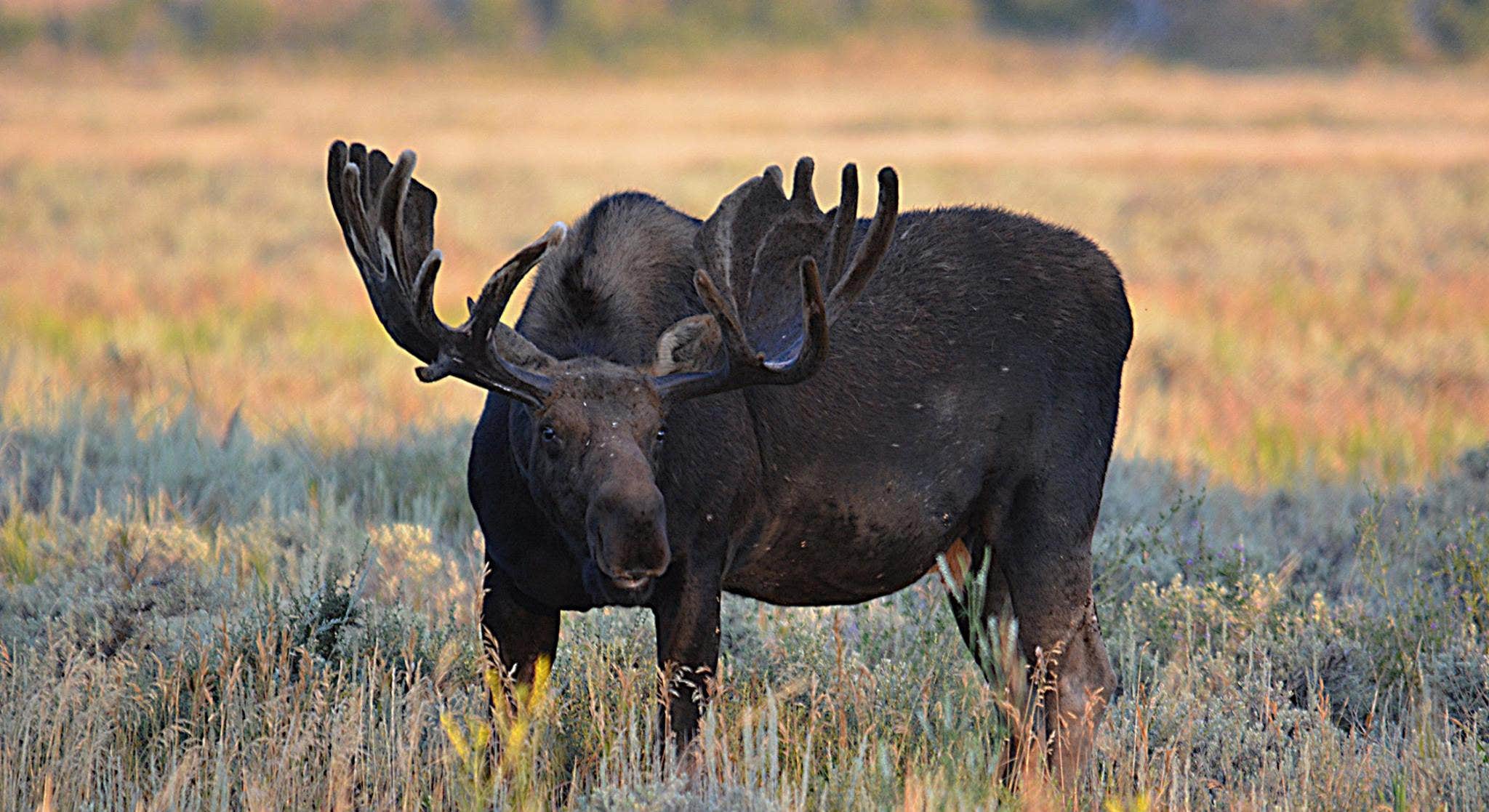 Photo by Deanna C
Photo by Deanna C
Wildlife Safety and Park Regulations 
Bear and Moose Safety
Grand Teton National Park is home to both black bear, grizzly bear, and moose, requiring specific safety measures from all visitors:
Food Storage Requirements:
- Use provided food storage lockers at all campgrounds for ALL food items
- Store ALL scented items (toiletries, trash, cooking gear) in food lockers or hard-sided vehicles
- Never store food or scented items in tents, even temporarily
- Keep a clean camp; wash dishes immediately after use
- Dispose of gray water in designated utility sinks, not in natural areas
- Store empty coolers in food lockers (bears recognize them as potential food sources)
- When dispersed camping, use bear canisters or properly hang food (at least 10 feet high and 4 feet from any vertical support)
- Never leave food items unattended, even briefly during mealtime
Bear Encounter Guidelines:
- Make noise while hiking to avoid surprising bears (conversation is better than bear bells)
- Hike in groups when possible
- Carry bear spray and know how to use it (keep it accessible, not in your pack)
- If you encounter a bear, stay calm and do not run
- For a bear at a distance, quietly back away and detour around it
- For a close encounter, speak in a calm, assertive voice and slowly back away
- If a bear charges, stand your ground and prepare to use bear spray
- In the unlikely event of physical contact, play dead with a grizzly (lie face down, protect neck) but fight back with a black bear
- Report all bear sightings to park rangers
Common Mistakes to Avoid:
- Leaving garbage or food scraps around camp
- Storing scented items like toothpaste in tents
- Cooking close to your tent (cook at least 100 yards away)
- Approaching bears for photographs
- Hiking quietly alone, especially at dawn/dusk
- Improperly hanging food (too low or too close to tree trunk)
- Forgetting about scented non-food items (lip balm, sunscreen, etc.)
- Using scented soaps or lotions in bear country
Park Regulations and Etiquette
| Regulation Category | Specific Rules | Penalties |
|---|---|---|
| Campfires | Allowed only in established fire rings Must be attended at all times Completely extinguish before leaving or sleeping Subject to seasonal fire restrictions Collect only dead and down wood where permitted | Fines starting at $225 Possible eviction from campground Criminal charges for wildfire ignition |
| Food Storage | All food, trash, toiletries must be in food lockers or hard-sided vehicles No food in tents at any time Dispose of trash in bear-resistant dumpsters Clean tables after use | Fines starting at $100 Confiscation of improperly stored items Possible eviction from campground |
| Quiet Hours | 10:00 PM to 6:00 AM Generator hours typically 8-10 AM, 12-2 PM, 5-7 PM No loud music at any time | Warning, then possible eviction Repeat violations may result in citation |
| Camping Limits | Maximum 6 people per site (standard sites) Maximum 2 vehicles per site 14-night stay limit per campground 30-night annual camping limit in the park No saving sites for others | Extra vehicle charges Possible eviction Ban from future reservations |
| Protected Resources | No collecting plants, rocks, antlers, artifacts No feeding or disturbing wildlife Stay on established trails No drones/UAVs in the park No digging trenches or building structures | Fines $100-$5,000 Possible arrest for serious resource damage Confiscation of collected items |
Additional Regulations:
- Check-in time is typically 1:00 PM, check-out by 11:00 AM
- Pets must be leashed at all times and cannot be left unattended
- Pets prohibited on all trails except paved pathways
- Bicycles allowed only on paved roads and designated bike paths
- All food and trash must be properly stored when site is unoccupied, even briefly
- Wildlife must be given distance: 100 yards from bears and wolves, 25 yards from all other wildlife
- Swimming is permitted in most lakes but at your own risk (no lifeguards)
Dispersed Camping Regulations:
When camping on national forest land outside the park:
- Camp at least 100 feet from water sources
- Stay within 150 feet of roads to minimize impact
- Camp only in designated dispersed sites (particularly in high-use areas like Shadow Mountain)
- Pack out all trash completely
- Follow all posted fire restrictions
- Maximum stay limit of 14 days in one location
- No camping within one mile of developed campgrounds
 Photo by Vanessa
Photo by Vanessa
Beyond the Campground: Activities and Exploration 
Day Trips from Grand Teton Campgrounds
From Southern Campgrounds (Gros Ventre):
- Town of Jackson, WY: Just 12 miles south of Gros Ventre Campground, Jackson offers dining, shopping, art galleries, and the famous town square with elk antler arches. The National Museum of Wildlife Art, just north of town, houses an impressive collection in a building that blends into the landscape. Jackson also hosts a traditional rodeo on summer Wednesday and Saturday evenings. The town provides all services campers might need: grocery stores, laundromats, outdoor gear shops, and more.
- National Elk Refuge: Bordering Grand Teton National Park to the south, this wildlife sanctuary hosts thousands of wintering elk (December-April). Summer visitors may not see the elk herds but can explore the refuge's diverse habitats with opportunities to spot pronghorn, bison, and various bird species. Hike or bike the paved pathway connecting Jackson to the park, or drive the scenic road along the refuge's edge.
- Mormon Row Historic District: Located in the park's southeast corner near Gros Ventre, this preserved homesteading community features the iconic Moulton Barns—perhaps the most photographed barns in America with their Teton backdrop. The area offers interpretive displays about early settlement and agricultural history. Visit at sunrise for spectacular photographs with alpenglow on the mountains.
From Central Campgrounds (Jenny Lake, Signal Mountain):
- Jenny Lake Scenic Drive: This one-way loop provides stunning views of the lake and mountains. Several pullouts allow for photography or short walks to the shoreline. The route connects to String Lake picnic area and trailheads, making it perfect for a half-day exploration with short hikes mixed in. The road's intimate feel, curving through forests with mountain glimpses, provides a different perspective than the main park road.
- Jackson Lake Boat Cruise: Several options depart from Colter Bay Marina: breakfast cruises to Elk Island (includes meal), scenic cruises with Teton geology narration, or sunset cruises with appetizers and drinks. These 1-2 hour trips provide unique views of the mountains from the water and often include wildlife sightings along the shoreline. Reservations recommended during peak season.
- Snake River Float Trip: Scenic float trips (non-whitewater) launch from Pacific Creek or Deadman's Bar, drifting through pristine river habitat with excellent opportunities for wildlife viewing and photography. Many visitors spot moose, bald eagles, beavers, and occasionally bears from the unique vantage point of the river. Professional guides provide park interpretation during the 2-3 hour journey.
From Northern Campgrounds (Colter Bay, Lizard Creek, Flagg Ranch):
- Yellowstone National Park: The south entrance to Yellowstone is just 30 minutes north of Flagg Ranch or about an hour from Colter Bay. A day trip can include Old Faithful and the Upper Geyser Basin (2-hour drive from Colter Bay), the Grand Canyon of the Yellowstone (2.5 hours), or the West Thumb Geyser Basin (75 minutes). For those based in northern Grand Teton, combining both parks makes practical sense.
- Oxbow Bend: This iconic sunrise photography location on the Snake River offers reflections of Mount Moran in still waters. Located near the Jackson Lake Junction, it's just 5-10 minutes from Colter Bay. Early morning often brings wildlife: moose feeding in the shallows, river otters playing, or eagles fishing. The pullout gets crowded at sunrise, so arrive early for the best position.
- Jackson Lake Lodge: Even if not staying at this historic lodge, visitors can enjoy its grand lobby with floor-to-ceiling windows framing the Tetons across Jackson Lake. The outdoor terrace offers dining with spectacular views. The lodge serves as a central hub for ranger talks, guided activities, and dining options from casual to upscale.
Top Hiking Trails Near Campgrounds
| Trail Name | Difficulty & Distance | Key Features |
|---|---|---|
| Hidden Falls & Inspiration Point | Easy to Moderate ~2 miles RT via boat shuttle 5-6 miles RT from South Jenny Lake TH ~500 ft gain | 80-foot cascading waterfall, panoramic views of Jenny Lake from Inspiration Point, family-friendly with boat shuttle option, gateway to longer Cascade Canyon hike, heavy visitation (go early or late) |
| Taggart Lake Loop | Easy 3.8 miles RT (loop) ~300 ft gain | Gorgeous subalpine lake with mountain reflections, aspen and conifer forests, regrowth areas from 1985 fire, good wildlife watching opportunities, connects to Bradley Lake for extended hike |
| Cascade Canyon | Moderate 9.0 miles RT from Inspiration Point (11.0 miles from South Jenny) ~1,000 ft gain | Stunning canyon between towering peaks, follows cascading creek upstream, frequent moose sightings, wildflowers in early summer, can extend to Lake Solitude (15 miles RT) |
| Signal Mountain Summit | Moderate 6.8 miles RT ~800 ft gain | Panoramic views of Jackson Hole valley, Snake River and Jackson Lake vistas, forested trail with occasional wildlife, alternative to driving summit road, less crowded than Jenny Lake area trails |
| Phelps Lake Loop | Easy to Moderate 7.2 miles RT (full loop) ~750 ft gain | Beautiful forest and lake with mountain backdrop, well-maintained interpretive trail, "Jump Rock" swimming spot, good bear habitat (sightings common), limited parking (arrive early) |
| Hermitage Point | Moderate 9.7 miles RT (loop) ~200 ft gain | Peaceful peninsula extending into Jackson Lake, forest, meadows, and lake views, less crowded than south park trails, good moose and waterfowl habitat, can be shortened to Heron Pond (3 miles RT) |
Trail Safety Tips:
- Carry bear spray and know how to use it (available for purchase at visitor centers)
- Start early to avoid afternoon thunderstorms (typically develop after noon)
- Carry at least 2-3 liters of water per person for day hikes
- Check trail conditions at visitor centers before starting
- Tell someone your hiking plans and expected return time
- Be prepared for rapid weather changes; carry rain gear and layers
- Use trekking poles for stream crossings and steep sections
- Stay on designated trails to protect fragile alpine vegetation
- Be prepared for lingering snow on high-elevation trails through July
- Check the forecast and turn back if storms threaten
Water Activities in Grand Teton
Grand Teton offers numerous water-based recreational opportunities on its pristine lakes and rivers:
Swimming Areas:
- String Lake: The most popular swimming destination in the park with shallow, warmer waters than other lakes. The beach area at the String Lake Trailhead provides easy access for families. The lake's clarity and reasonable temperatures (mid-60s°F by mid-summer) make it ideal for cooling off after hiking. Morning visits offer calmer conditions before afternoon crowds arrive.
- Colter Bay Swim Beach: A designated swimming area on Jackson Lake with a small sandy beach and swimming area marked by buoys. Located near the visitor center with nearby amenities including restrooms, picnic tables, and the marina store. The water remains quite cold even in summer (rarely above 60°F), but the mountain backdrop provides a spectacular setting for a refreshing dip.
- Leigh Lake Coves: Several secluded spots along the eastern shoreline offer more private swimming locations for those willing to hike 1-2 miles along the shoreline trail. These quiet coves with rocky or pebbly beaches provide crystal-clear water and often less crowded conditions than String Lake.
Boating Options:
- Jackson Lake Marina: Located at Colter Bay Village, the marina offers motorboat, kayak, canoe, and stand-up paddleboard rentals. The large lake (15 miles long) provides ample exploration possibilities, from secluded coves to island hopping. Guided scenic cruises and fishing charters also depart from here. Powerboating, water skiing, and wakeboarding are permitted on Jackson Lake, unlike other park waters.
- Jenny Lake Boating: A concessioner operates shuttle boats across Jenny Lake (fee required) as well as kayak and canoe rentals. The shuttle saves hikers 2 miles round-trip to Hidden Falls and Inspiration Point. Private motorized boats are prohibited on Jenny Lake, creating a peaceful paddling environment.
- Snake River Floating: The Snake River through Grand Teton offers pristine floating opportunities with incredible mountain views. Commercial guided scenic float trips operate from several locations, particularly Deadman's Bar to Moose Landing (10 miles). Private floating requires knowledge of river conditions, proper equipment, and sometimes permits depending on the section.
Fishing Information:
- Grand Teton offers exceptional fishing for native cutthroat trout as well as lake trout, brown trout, and mackinaw
- Wyoming fishing license required (available at park visitor centers and gateway communities)
- Specific regulations apply to different waters; check the fishing regulations handout available at entrance stations
- Jackson Lake is known for lake trout and mackinaw; Snake River for fine fly fishing for cutthroat
- Most productive fishing typically occurs early morning or evening hours
- Catch-and-release fishing with artificial lures encouraged for native species
- Fishing guided services available through park concessionaires
The Dyrt Community Insights 
Ranger Recommendations
The Dyrt Rangers - experienced campers who document and review camping areas - offer these insider tips for the Grand Teton area:
Best Sites at Popular Campgrounds:
"At Jenny Lake, sites 4-15 generally offer the most privacy and better views of the mountains," notes a Dyrt Ranger who visits annually. "At Colter Bay, look for sites in the 200 loop which has more mature trees and better spacing between sites." For Signal Mountain, Rangers consistently recommend sites 17-24 which offer glimpses of Jackson Lake through the trees. At Gros Ventre, loops C and D offer the best mountain views and proximity to the river where wildlife sightings are common.
Timing Tips for Better Experiences:
"The sweet spot for Grand Teton camping is September after Labor Day," suggests a long-time visitor. "The aspens turn golden, elk begin bugling, and campgrounds have greater availability." Several Rangers recommend arriving at visitor centers and popular trailheads before 8:00 AM to avoid crowds and parking challenges. For wildlife viewing, dawn and dusk provide the best opportunities.
Weather Adaptation Strategies:
"The mountain weather motto applies perfectly to Grand Teton: if you don't like the weather, wait 15 minutes," says one frequent camper. Even in July, nights regularly drop into the 30s°F, so Rangers emphasize proper sleeping gear as essential. "I bring a 20°F sleeping bag plus a liner even in August," notes a tent camper. For afternoon thunderstorms (common in summer), several experienced campers recommend planning hikes for early morning and saving driving tours, visitor centers, or in-town activities for afternoons when storms typically roll through.
Wildlife Viewing Advice:
"For moose, check willow thickets along the Gros Ventre River in early morning, particularly in fall during the rut," recommends one wildlife photographer. "Elk are most visible at dawn and dusk in the open areas near Mormon Row and Timbered Island." Multiple Rangers emphasize Willow Flats near Jackson Lake Lodge as prime habitat for moose, elk, and occasional bears.
Top-Rated Sites from The Dyrt Community
| Category | Top Pick & Rating | Key Highlights |
|---|---|---|
| Most Scenic Campground | Jenny Lake Campground 4.8/5 stars | Unrivaled location at the base of the Tetons, walking distance to Jenny Lake, tent-only atmosphere creates quieter setting, direct access to most popular trails, new shower facilities added in recent renovation |
| Best for Families | Colter Bay Campground 4.6/5 stars | Comprehensive amenities nearby, ranger programs and activities, grocery store, restaurants, and laundry, easier booking than other park campgrounds, lake access for swimming and boating |
| Wildlife Viewing | Gros Ventre Campground 4.5/5 stars | Frequent moose sightings along river, located in prime elk viewing area, open setting with good visibility, less crowded than central park campgrounds, better last-minute availability |
| Best for RVs | Headwaters Campground (Flagg Ranch) 4.3/5 stars | Full hookups available, accommodates larger rigs, central to both Grand Teton and Yellowstone, good cell service, on-site restaurant and store |
| Best Free Camping | Shadow Mountain Dispersed 4.5/5 stars | Panoramic Teton views at upper sites, no camping fees, first-come, first-served flexibility, multiple site options for various vehicle types, proximity to park activities |
| Best Solitude | Lizard Creek Campground 4.4/5 stars | Remote location with fewer crowds, quieter, more rustic atmosphere, lake access with mountain views, larger distance between sites, cooler temperatures in summer heat |
Community Insights and Recommendations
Jenny Lake Excellence: The Dyrt community's reviews consistently highlight Jenny Lake as the premier camping location for those seeking to immerse themselves in the Teton experience. Campers describe "waking up to alpenglow on the peaks" and appreciate the tent-only atmosphere that creates a more traditional camping feel. The recent addition of hot showers has only enhanced its appeal.
Family-Friendly Colter Bay: For those traveling with children, Colter Bay earns high marks for its abundance of activities and conveniences. Families appreciate the nearby visitor center with ranger programs, the accessible swim beach, and options for boat rentals. The adjacency to stores and restaurants makes meal planning more flexible.
Wildlife at Gros Ventre: Wildlife enthusiasts gravitate toward Gros Ventre, where reviews frequently mention moose sightings right from campsites along the river. "We watched a mother moose and calf browse through the campground at dawn," wrote one camper. The campground's location away from the busier park corridor creates a more peaceful experience.
RV Convenience: RV travelers consistently recommend Headwaters for its full hookups and proximity to both national parks, making it an excellent base camp for exploring the greater Yellowstone ecosystem.

Responsible Camping Practices 
Grand Teton's fragile ecosystem and wildlife habitat require thoughtful camping practices from all visitors:
Wildlife Protection:
- Secure ALL food, scented items, and anything that might attract wildlife in hard-sided vehicles or food storage lockers when not in immediate use
- Never approach wildlife for photos; use binoculars or telephoto lenses instead
- Keep required distance from animals: 100 yards (football field) from bears and wolves, 25 yards from all other wildlife
- Drive cautiously, especially at dawn and dusk when animals are most active
- Never feed any wildlife, intentionally or accidentally
- Keep a clean camp, washing dishes immediately after meals
- Make noise while hiking to avoid surprising wildlife
- Carry bear spray and know how to use it when in backcountry
- Report unusual wildlife behavior or encounters to park rangers
- Keep pets leashed where allowed and never let them chase wildlife
Leave No Trace Principles:
- Pack out everything you bring in; leave no trash behind
- Use established fire rings only and fully extinguish fires
- Stay on designated trails and camp only in designated sites
- Respect closures for wildlife protection or habitat restoration
- Minimize campfire impacts; use a stove for cooking when possible
- Collect only dead and down wood for fires where permitted
- Camp on durable surfaces and at least 200 feet from water sources
- Dispose of human waste properly in provided facilities or bury 6-8 inches deep when in backcountry
- Leave natural objects and cultural artifacts where you find them
- Keep noise levels down to respect wildlife and other visitors
- Avoid trampling vegetation around campsites and trails
Water Conservation and Protection:
- Use minimal water for washing dishes and personal hygiene
- Dispose of dishwater and gray water in designated utility sinks, not on the ground
- Use biodegradable soap sparingly and at least 200 feet from natural water sources
- Report any pollution or contamination observed in lakes or streams
- Carry sufficient water containers to reduce plastic bottle waste
- Consider bringing a water filter for refilling from natural sources when in backcountry
- Never wash directly in lakes or streams, even with biodegradable soap
- Respect wetlands and riparian areas by keeping distance and not disturbing
Campsite Etiquette:
- Observe quiet hours (typically 10 PM to 6 AM)
- Keep generator use to designated hours and areas
- Limit artificial lighting to preserve dark night skies
- Respect site capacity limits and boundaries
- Leave your site clean for the next camper
- Properly douse campfires with water until cool to the touch
- Share public facilities like water spigots and dishwashing stations considerately
- Follow campground-specific regulations posted at entrance kiosks
- Consider fellow campers when using electronic devices or playing music
- Arrive and depart during daylight hours when possible to minimize disturbance
Frequently Asked Questions 
When is the best time to camp in Grand Teton National Park? The optimal time for most campers is late June through mid-September when all campgrounds are open and weather is most reliable. July and August offer the warmest temperatures but also the largest crowds. Early September brings fewer people, golden aspen trees, and bugling elk but cooler nights. Late May and early June can be beautiful with wildflowers and fewer crowds, but expect more rain, some snow at higher elevations, and not all facilities open. Remember that the park's high elevation means night temperatures drop significantly—often into the 30s°F—even during peak summer months, so prepare with warm sleeping gear regardless of when you visit.
How difficult is it to get a campsite in Grand Teton? During peak season (June-August), securing a campsite requires advance planning. All in-park campgrounds operate on a reservation-only system through Recreation.gov, with bookings available 6 months in advance. Popular campgrounds like Jenny Lake often fill within minutes when the reservation window opens. Gros Ventre Campground typically has the best availability. For those without reservations, options include dispersed camping on national forest land (Shadow Mountain, Curtis Canyon) or commercial campgrounds outside the park. The best strategy is setting a calendar reminder for the earliest booking date for your trip (exactly 6 months prior), having an account already set up, and being ready at 8:00 AM Mountain Time when sites become available.
What's the difference between the various campgrounds in Grand Teton? Each campground offers a distinct experience. Jenny Lake is small, tent-only, and located directly beneath the Tetons with easy trail access but minimal amenities (though it recently added showers). Colter Bay is large with extensive services (store, laundry, showers) and good family activities but can feel more crowded. Signal Mountain offers a mix of forest sites and lake views with moderate amenities. Gros Ventre is the largest and typically last to fill, known for wildlife sightings but farther from main attractions. Lizard Creek provides a remote, quiet experience on the northern shore of Jackson Lake. Headwaters at Flagg Ranch sits between Grand Teton and Yellowstone with full hookups for RVs. Location, services, and atmosphere are the key differentiators—prioritize based on what matters most for your camping style.
How do I protect my food from bears while camping? Bear safety is mandatory in Grand Teton. All developed campgrounds provide metal food storage lockers, which must be used for ALL food, coolers, cooking equipment, toiletries, and scented items when not immediately in use. Nothing that might attract bears should ever be left unattended at your site, even for a few minutes. Never store food or scented items in tents. When dispersed camping outside the park, use a hard-sided bear canister placed at least 100 yards from your tent, or properly hang food from a tree (at least 10 feet high and 4 feet from the trunk). Clean dishes immediately after eating and dispose of gray water in designated utility sinks. Store empty coolers in lockers or vehicles, as bears recognize them as potential food sources. These precautions protect both you and the bears—a bear that becomes food-conditioned often ends up being relocated or euthanized.
What should I do if I encounter a bear? First, stay calm and determine if it's a grizzly (humped shoulders, dish-shaped face) or black bear (straight profile, taller ears). If the bear hasn't noticed you, quietly back away and detour around it, maintaining at least 100 yards distance. If it has seen you, speak in a calm, assertive voice saying something like "Hey bear, I'm just passing through" while slowly backing away. Never run, which can trigger a chase response. Travel in groups when possible and make noise while hiking to avoid surprising bears. Always carry bear spray in an accessible location (not in your backpack) and know how to use it. If a bear charges, stand your ground and prepare to use bear spray when the bear is within 30-60 feet. In the rare event of physical contact, play dead with a grizzly (lie face down, protect neck with hands) but fight back against a black bear. Report all bear encounters to park rangers.
Can I bring my dog camping in Grand Teton? Yes, dogs are allowed in developed campgrounds, picnic areas, parking lots, and on boats on Jackson Lake, but with significant restrictions. Dogs must be on a leash no longer than 6 feet at all times and cannot be left unattended. Dogs are NOT permitted on hiking trails, in the backcountry, in visitor centers, or on the multi-use pathway. These restrictions exist to protect wildlife, prevent conflicts with other visitors, and keep your pet safe. If planning activities where dogs aren't allowed, consider doggy daycare options in Jackson. When camping with your dog, be aware that bears and other wildlife may be attracted to pet food, so store it securely just like human food. Always clean up after your pet and dispose of waste properly. For those spending significant time hiking, Grand Teton may not be the ideal destination for bringing pets due to the trail restrictions.
What options exist for winter camping in Grand Teton? Winter camping in Grand Teton requires serious preparation and experience. All developed campgrounds close by mid-October and don't reopen until late April or May. Winter backcountry camping is permitted with a free permit from the Craig Thomas Discovery Center, but it's only suitable for those with winter camping experience, proper equipment (-20°F sleeping bags minimum), and avalanche awareness. Alternatives include staying in Jackson or Teton Village and doing day trips into the park. Some winter visitors explore using cross-country skis or snowshoes, while others enjoy the groomed snowmobile routes in the John D. Rockefeller Jr. Memorial Parkway between Grand Teton and Yellowstone. The park's stark winter beauty and wildlife viewing opportunities make it worth visiting in the cold months, but overnight options are extremely limited without specialized skills and gear.
Planning Resources
Essential Grand Teton Links
- The Dyrt Grand Teton Campground Reviews - User reviews and photos of campgrounds in and around the park
- Grand Teton National Park Official Website - Current conditions, alerts, and regulations
- Recreation.gov Grand Teton Campgrounds - Official reservation platform for all in-park campgrounds
- Grand Teton Road Status - Current information on park road conditions and closures
- Grand Teton Trail Conditions - Updates on hiking trails, including snow levels and closures
- Bridger-Teton National Forest - Information on surrounding forest lands, including dispersed camping
- Wyoming Game & Fish Department - Fishing licenses and regulations
- Grand Teton Association - Educational resources and park guides
- Jackson Hole & Greater Yellowstone Visitor Center - Local area information and services
- Wyoming Road Conditions - Highway information, especially important during shoulder seasons
Reservation Timeline
| Time Period | Reservation Task | Platform/Details |
|---|---|---|
| 6 Months Before Trip | Book in-park campgrounds and research backcountry permit options | Recreation.gov (opens 8:00 AM MT exactly 6 months in advance) Set calendar reminders for booking day Have account created with payment ready |
| 3-4 Months Before | Reserve outside-park alternatives and book guided activities | Private campground websites Outfitter websites for activities USGS website or REI for park pass |
| 1-2 Months Before | Research dispersed camping areas and plan hiking routes | Forest Service websites Hiking guidebooks Recreation.gov for cancellations |
| 2-3 Weeks Before | Check fire restrictions and road status | NPS and Forest Service alerts Wyoming DOT website Wyoming Game & Fish website |
| 1 Week Before | Check weather forecast and finalize gear list | National Weather Service AllTrails or Gaia GPS for offline maps Print backup paper maps |
| Day Before Arrival | Check road conditions and purchase supplies | Wyoming Road Information (511) Grocery stores in Jackson Gas stations (limited in-park services) |
Grand Teton Camping Checklist
Reservations and Documents:
- Campground reservation confirmation (printed and digital copies)
- Park entrance pass or America the Beautiful Pass
- Photo ID and credit cards
- Vehicle registration and insurance
- Fishing licenses if planning to fish
- Maps (physical and digital with offline access)
- Campground information and regulations
- Emergency contact list
Shelter and Sleeping:
- Tent with rainfly and footprint
- Extra stakes and guy lines for wind
- Sleeping bag rated for cold nights (20°F or lower recommended)
- Sleeping pad with good R-value (4+)
- Pillow and extra blankets
- Tarp for additional weather protection
- Lantern and/or headlamp with extra batteries
- Camp chairs
Kitchen Equipment:
- Camp stove and fuel
- Lighter/matches in waterproof container
- Cookware (pots, pans, kettle)
- Cooking and eating utensils
- Plates, bowls, cups, mugs
- Cutting board and knife
- Coffee/tea making supplies
- Cooler and ice
- Water containers and treatment method
- Biodegradable soap and sponge
- Trash bags and recycling bags
- Food storage containers
- Dish washing basin
Clothing:
- Moisture-wicking base layers
- Insulating mid-layers (fleece or down)
- Waterproof/windproof jacket and pants
- Long-sleeve shirts and pants (for sun/bug protection)
- T-shirts and shorts

